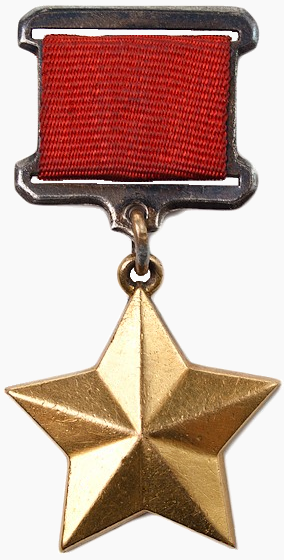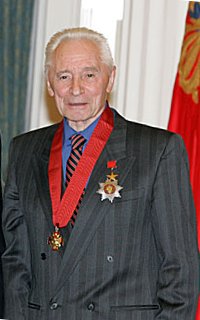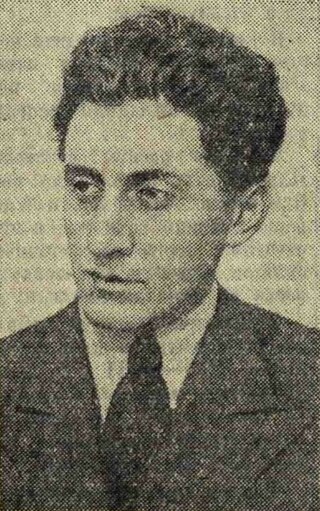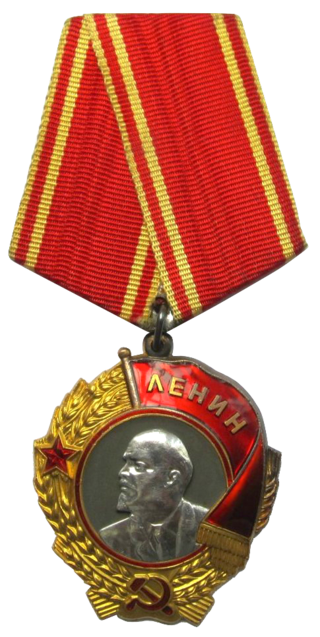
Aleksei Aleksandrovich Gubarev was a Soviet cosmonaut who flew on two space flights: Soyuz 17 and Soyuz 28.

The title Hero of the Soviet Union was the highest distinction in the Soviet Union, awarded together with the Order of Lenin personally or collectively for heroic feats in service to the Soviet state and society. The title was awarded both to civilian and military persons.

The Hero of Socialist Labour was an honorific title in the Soviet Union and other Warsaw Pact countries from 1938 to 1991. It represented the highest degree of distinction in the USSR and was awarded for exceptional achievements in Soviet industry and culture. It provided a similar status to the title of Hero of the Soviet Union, which was awarded for heroic deeds, but differed in that it was not awarded to foreign citizens.
Pavel Aleksandrovich Solovyov (Soloviev) was a Soviet engineer born in Alekino in Kineshemsky District of Ivanovo Oblast. He specialised in the design of aircraft engines.
The title of Hero is presented by various governments in recognition of acts of self-sacrifice to the state, and great achievements in combat or labor. It is originally a Soviet-type honor, and is continued by several nations including Belarus, Russia, and Ukraine. It was also awarded to cities and fortresses for collective efforts in heroic feats. Each hero receives a medal for public display, special privileges and rights for life, and the admiration and respect of the nation. Some countries without Soviet connections also award Hero honours.

Yury Nikolayevich Grigorovich is a Soviet and Russian dancer and choreographer who dominated the Russian ballet for 30 years.

Semyon Ariyevich Kosberg was a Soviet engineer, expert in the field of aircraft and rocket engines, Doctor of Technical Sciences (1959), Hero of Socialist Labor (1961).

Yevgeny Viktorovich Vuchetich was a Soviet sculptor and artist. He is known for his heroic monuments, often of allegoric style, including The Motherland Calls, the largest sculpture in the world at the time.

Alexey Fyodorovich Tryoshnikov was a Soviet polar explorer and leader of the 2nd Soviet Antarctic Expedition and the 13th Soviet Antarctic Expedition.
Vladimir Aleksandrovich Engelgardt was a Soviet biochemist, academician of the Soviet Academy of Medical Sciences (1944), academician of the Soviet Academy of Sciences (1953), and Hero of Socialist Labor (1969). He was the founder and the first director of the Institute of Molecular Biology of the Russian Academy of Sciences.

Lev Yefimovich Kerbel was a Soviet and Russian sculptor of socialist realist works. Kerbel's creations included statues of Karl Marx, Vladimir Lenin, Yuri Gagarin, which were sent by Soviet Government as gifts to socialist and the Third World countries across the world.

Gury Ivanovich Marchuk was a Soviet and Russian scientist in the fields of computational mathematics, and physics of atmosphere. Academician ; the President of the USSR Academy of Sciences in 1986–1991. Among his notable prizes are the USSR State Prize (1979), Demidov Prize (2004), Lomonosov Gold Medal (2004).
Armenians in Belarus refers to ethnic Armenians living in Belarus. They numbered 8,512 as of the 2009 census and mainly live in Minsk.
Georgy Sergeev was a Soviet designer of artillery and rocket systems, Hero of Socialist Labor.
Dmitry Arkadyevich Nalbandyan was a Soviet and Armenian painter and animator.

Ivan Lyudvigovich Knunyants, was a Soviet chemist of Armenian origin, academician of the Academy of Sciences of the Soviet Union, a major general and engineer, who significantly contributed to the advancement of Soviet chemistry. He made more than 200 inventions, many of which used in the Soviet industry.

Sergei Nikitich Kovalev was a Russian engineer and architect who designed nuclear submarines for the Soviet Navy while leading the Rubin Design Bureau.

The Order of Lenin was an award named after Vladimir Lenin, the leader of the October Revolution. It was established by the Central Executive Committee on 6 April 1930. The order was the highest civilian decoration bestowed by the Soviet Union. The order was awarded to:

Tursunoy Makhmudovna Akhunova was one of the first Uzbek women cotton harvester drivers as well as recipient of the title Hero of Socialist Labor in 1959 and 1978 for high cotton yields. A member of the Communist Party since 1962 and a prominent initiator for mechanization of the cotton harvest, she became a prominent figure in Uzbekistani politics, serving in the Supreme Soviet of the USSR of the 6th-8th convocations from 1962-1974 and well as the Presidium of the Supreme Soviet.
Lyudmila Stepanovna Byakova is a Soviet and Russian seamstress-minder who worked at the Kirovo-Chepetsk garment factory and at the Kurgan Industrial Sewing Association. She supported an initiative by the Leningrad seamstress Chistyakova's "Five-year plan – two personal five-year plans.", finishing 21 annual assignments and training 41 young drivers over the course of a decade. Byakova led the All-Russian School of Professional Excellence and gave her experience of advanced methods of work to 24 seamstresses from various garment factories in the Soviet Union. She was an elected deputy of the Congress of People's Deputies of the Soviet Union from women's groups from 1989 to 1991 and was on the Committee for Women, Family Protection, Motherhood and Childhood. Byakova was a delegate at the 27th Congress of the Communist Party of the Soviet Union in 1986 and at the 16th Congress of the All-Union Central Council of Trade Unions. She has been awarded the Jubilee Medal "In Commemoration of the 100th Anniversary of the Birth of Vladimir Ilyich Lenin"; the Order of the Red Banner of Labour; the USSR State Prize; the Order of the October Revolution and the title of Hero of Socialist Labor with the Order of Lenin.













